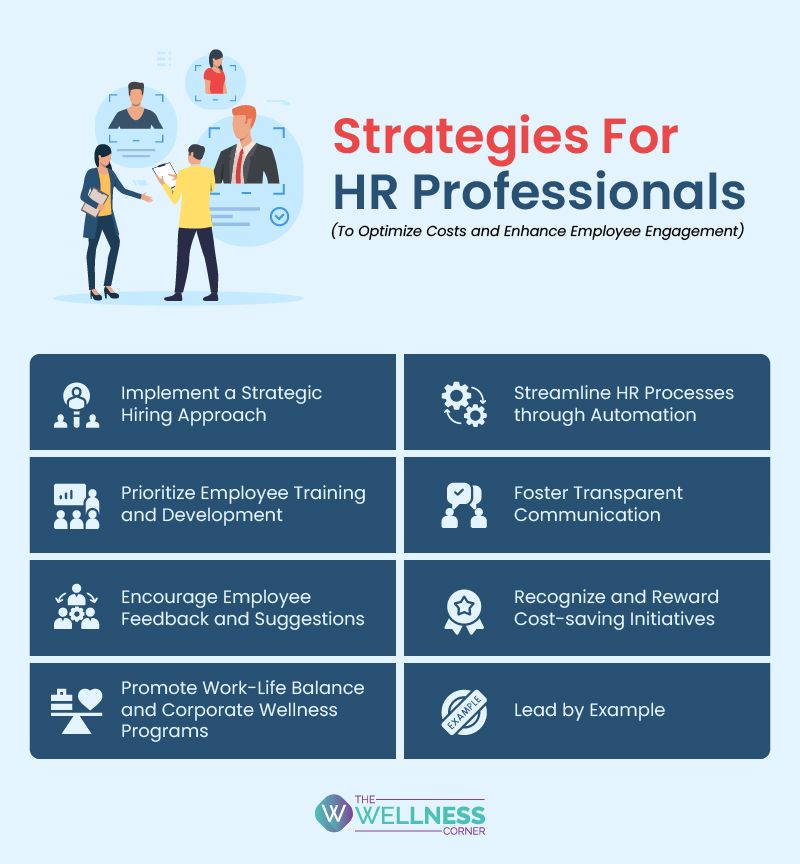Strategies For HR Professionals To Optimize Costs and Enhance Employee Engagement

In today's competitive business landscape, organizations, irrespective of their size, face constant pressure to reduce costs and improve employee engagement. HR professionals play a pivotal role in navigating these challenges as they represent the company and are responsible for cost-cutting measures and fostering a culture of engagement.
However, HR needs to handle cost-cutting discussions delicately, as they can inadvertently induce stress among employees. This article outlines effective strategies for HR professionals to successfully manage cost-cutting initiatives while promoting employee engagement.

1) Implement a Strategic Hiring Approach:
During cost-cutting periods, some companies may halt their recruitment efforts. However, it is not always necessary for HR to stop hiring altogether. Instead, HR should focus on refining the recruitment process to ensure that only the most suitable candidates are selected. By prioritizing candidates who align with the company's values and culture, HR can enhance employee engagement and reduce turnover.
2) Streamline HR Processes Through Automation:
Efficient and streamlined HR processes contribute to a positive work environment, resulting in increased employee engagement. Manual and time-consuming HR tasks can create unnecessary barriers between HR and employees, leading to frustration and disengagement. By automating processes such as leave approvals, flexible work hours, and performance reviews, HR can improve efficiency, eliminate bottlenecks, and create a more people-centric experience for employees.

3) Prioritize Employee Training and Development:
Investing in employee training and development not only enhances skills but also promotes engagement. When employees have access to continuous learning opportunities, they feel valued and motivated to perform better. HR should prioritize providing training programs that cater to both personal and professional growth. This not only boosts employee satisfaction but also reduces long-term costs by enabling internal promotions and multi-skilled employees.
4) Foster Transparent Communication:
During cost-cutting measures, HR professionals must maintain transparent and open communication with employees. It helps to alleviate concerns and build trust within the organization. HR should proactively address any potential rumors or misconceptions, providing clear explanations for the cost-cutting decisions and emphasizing the shared goals of the company and its employees.
5) Encourage Employee Feedback and Suggestions:
Involving employees in decision-making can significantly improve engagement and generate cost-saving ideas. HR should create platforms for employees to share feedback, suggestions, and innovative cost-cutting solutions. HR can make employees feel valued and engaged in cost-cutting efforts by actively listening to and implementing their ideas.
6) Recognize and Reward Cost-saving Initiatives:
HR professionals should acknowledge and reward employees who contribute to cost-saving initiatives to boost employee engagement during cost-cutting. HR's recognition of employees' efforts, whether through monetary incentives or non-monetary rewards like public appreciation, creates a positive and motivating work environment. This recognition encourages active participation in cost-cutting measures and strengthens employees' sense of belonging within the organization.
7) Promote Work-Life Balance and Corporate Wellness Programs:
During periods of cost-cutting, employees may experience heightened stress and anxiety. HR should prioritize promoting work-life balance and corporate wellness programs to mitigate these challenges. By offering flexible work arrangements, wellness initiatives, and access to an Employee Assistance Program (EAP), HR can help employees navigate the pressures of cost-cutting while maintaining their well-being and engagement.
8) Lead by Example:
HR professionals should lead by example in times of cost-cutting. They should demonstrate resilience, empathy, and transparency in their actions and communications. It sets a positive tone for the entire organization and encourages employees to embrace the necessary changes while maintaining a sense of engagement and commitment to the company's mission.
Conclusion:
By incorporating these strategies, including strategic hiring, streamlined HR processes, employee training and development, transparent communication, employee involvement, recognition of cost-saving efforts, promotion of work-life balance, and corporate wellness programs, HR professionals can effectively manage cost-cutting initiatives while enhancing employee engagement.
Leveraging an Employee Assistance Program (EAP) can further support employees' well-being and provide resources for mental health support. By implementing these approaches, HR can successfully navigate cost-cutting measures without sacrificing employee well-being or overall employee experience.